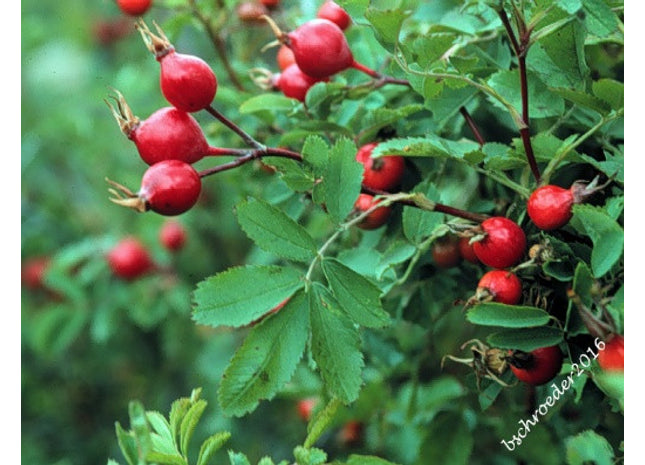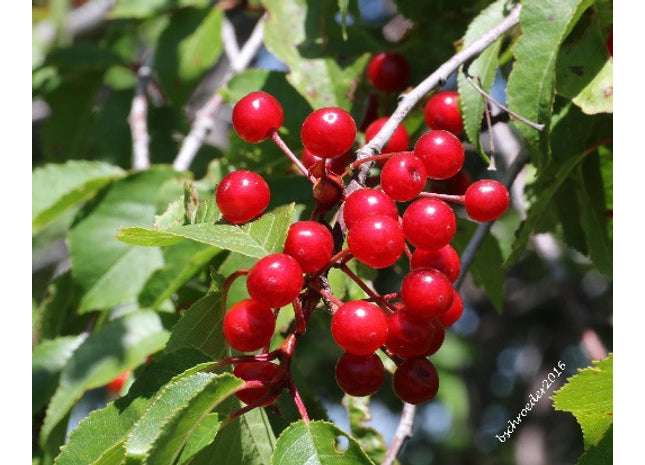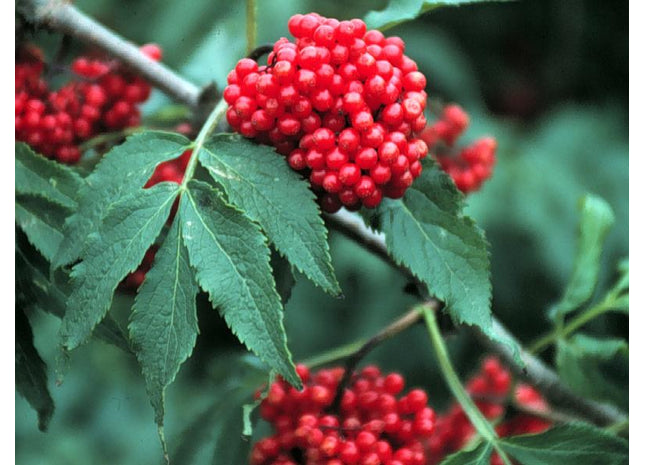Shrub & Berry Seeds

Agroforestry Solutions 'Indian Head' Hedge Rose Seed
Latin Name: Rosa rugosa x Rosa woodsii DESCRIPTION Family: Rosaceae Native Range: Origin unknown, introduced from Europe Seed Source: Seed production orchard near Indian Head Saskatchewan. Height and Spread: 2m x 2m (25 years) Overview: `Indian Head` Hedge rose is an improved seed strain developed for tree planting in cold temperature regions. It is a small shrub suitable for agroforestry applications. The fruit is a source of Vitamin C. It has showy, pink flowers attractive to pollinators Fruits: Fruit is a hip 1.2 cm in diameter, turning fleshy and bright red when mature in late August. Average number of seeds/packet: 600 SEED TREATMENT / SOWING Stratification: Stratify in moist sand (10 percent moisture) for 90 days at 20°C followed by 120 days at 5°C. Acid scarification for 30 minutes can substitute for warm stratification Ideal sowing time: Sow 0.5 cm deep, 50 seeds/meter; Greenhouse - sow 3 seeds per cell. Sowing instructions: Sow 0.5 cm deep, 50 seeds/meter; Greenhouse - sow 3 seeds per cell. Growing conditions: 'Indian Head' hedge rose grows well on most soils except those that are excessively wet, or dry, or soils affected by high pH or salinity AGROFORESTRY VALUE 'Indian Head' hedge rose, is used in farmstead and field shelterbelts, Ecobuffers, and wildlife habitat plantings. The continuous flowering makes it attractive to pollinators. Many song and game birds utilize this shrub for food and habitat.
$20.00 - $25.00

AgroForestry Solutions 'Loggerhead' Arnold Hawthorn Seed
Latin Name: Crataegus arnoldiana DESCRIPTION Family: Rosaceae Native Range: Native to eastern Canada. Seed Source: Seed production orchard near Indian Head Saskatchewan. Height and Spread: 5m x 4m (25 years) Overview: Found in open coulees and bottomlands. Arnold Hawthorn is a hardy medium shrub excellent for agroforestry applications. 'Loggerhead' Arnold hawthorn is an improved seed strain developed for cold, dry climates. Named for the loggerhead shrike, a predatory bird that uses the thorns of hawthorn to impale its prey. Fruits: Fruit is 1.5 cm in diameter, turning fleshy and bright red when mature in late August. Average number of seeds/packet: 250 SEED TREATMENT / SOWING Stratification: Stratify in moist sand (10 percent moisture) for 90 days at 20°C followed by 180 days at 5°C. Ideal sowing time: Non-pretreated seed outdoors in July (will germinate the following spring) or stratified seed in spring. Sowing instructions: Sow 1 cm deep,30 seeds/meter; Greenhouse - sow 3 seeds per cell. Growing conditions: Loggerhead grows well on most soils except those that are excessively wet, or dry, or soils affected by high pH or salinity AGROFORESTRY VALUE Arnold hawthorn is used in farmstead and field shelterbelts, Eco-Buffers, and wildlife habitat plantings. The vigorous, dense growth makes it useful for shelterbelts and screening. The attractive form, foliage, and flowering is of ornamental value. Many song and game birds including the endangered loggerhead shrike utilize this tree for food and habitat.
$20.00 - $25.00

AgroForestry Solutions 'Crimson' Pin Cherry
Latin Name: Prunus pensylvanica DESCRIPTION Family: Rosaceae Native Range: Native to most of the forested regions of Canada. Seed Source: Pin cherry seed block, near Indian Head Saskatchewan. Height and Spread: 6m x 3m (5 years) Overview: 'Crimson' pin cherry seed strain is adapted to cold temperate dry climates. A pioneer plant quickly colonizing sites this seed strain produces small edible tart cherries. Fruits: A round single-seeded bright red cherry. About 150 seeds. SEED TREATMENT / SOWING Stratification: Pre-soak seed for 24 hours then stratify in moist sand (10 percent moisture) for 120 days at 5°C. Ideal sowing time: Non-pretreated seed outdoors in late September (will germinate the following spring) or stratified seed in spring. Sowing instructions: Outdoors - sow 2.0 cm deep, 50 seeds/meter; Greenhouse - sow 3 seeds per cell. Growing conditions: ’Crimson’ pin cherry grows well on a wide range of soils. As a colonizer, it will flourish on most disturbed sites. It prefers full sunlight. AGROFORESTRY VALUE 'Crimson' pin cherry is used in farmstead and field shelterbelts, Ecobuffers, wildlife habitat plantings. It is an important component of multi-species Ecobuffers, nursing the seedlings of longer-lived species beneath them. Many song and game birds utilize this small tree for food and habitat. The cherries can be preserved as jelly or dried.
$20.00

AgroForestry Solutions Nanking Cherry Seed
Latin Name: Prunus tomentosa DESCRIPTION Family: Rosaceae Native Range: Northern and western China and Mongolia Seed Source: Seed production orchard near Indian Head, Saskatchewan. Height and Spread: 1.5m x 1.5m Overview: Nanking Cherry cherry is an excellent choice for fruit gardens or agroforestry planting in cold temperate regions. It also makes an attractive hedge. This seed strain was selected because of its consistent production of tangy red cherries. Cross pollination is required for fruit production so more than one plant is required. Fruits: Cherry red drupe. Average number of seeds/packet: 150 SEED TREATMENT / SOWING Stratification: Soak seeds for 24 hours then stratify in moist sand (10 percent moisture) for 100 days at 5°C. Ideal sowing time: Non-pretreated seed outdoors in late July or early August (will germinate the following spring) or stratified seed in spring. Sowing instructions: Outdoor seedbed - Sow 2 cm deep and 50 seeds/meter; Greenhouse - sow 3 seeds per cell 1 cm deep. Growing conditions: Nanking cherry is hardy and will grow in a variety of soils but will not tolerate heavy shade. AGROFORESTRY VALUE Nanking cherry is known for its fragrant pink flowers along its branches in the spring, with forest green foliage. It is a good choice for attracting birds. Both you and the wildlife will love its edible red cherries. Fruit can be tangy but is great for jams, jellies, and pies. Extremely winter hardy.
$20.00

'Guiton' Red Elder Seed
Latin Name: Sambucus racemosa DESCRIPTION Family: Caprifoliaceae Native Range: Native to most regions of Canada and northern United States. Seed Source: Natural stand of red elder near Thunderhill, Manitoba. Height and Spread: 3m x 2m (5 years) Overview: 'Guiton' red elder is a medium fruit-bearing shrub that is valuable for wildlife habitat. The seeds train was named in honour of William Guiton a tree planting technician at the Dominion Forest Nursery Station from 1913 to 1931. Fruits: A round single-seeded bright red cherry, 0.5 cm in diameter. Large clusters of small, bright red, fleshy berries appear in summer. Average number of seeds/packet: 2,250 SEED TREATMENT / SOWING Stratification: Pre-soak seed for 24 hours then stratify in moist sand (10 percent moisture) for 90 days at 20C followed by 120 days at 5°C. Ideal sowing time: Non-pretreated seed outdoors in late September (will germinate the following spring) or stratified seed in spring. Sowing instructions: Outdoors - Sow 2.0 cm deep, 50 seeds/meter; Greenhouse - sow 3 seeds per cell. Growing conditions: ‘Guiton' Red elder favors deeper, loamy sands and silts and nutrient-rich sites with good drainage, ample moisture, and a pH of 5.0 to 8.0. It is shade tolerant but prefers a sunny exposure. AGROFORESTRY VALUE 'Guiton' red elder is used in Eco-Buffers and wildlife habitat plantings. Its dense roots and rhizomes make it useful for soil stabilization and erosion control on moist sites including streambanks. Red elder provides fair to good food and cover for birds plus small and large mammals. Hummingbirds collect nectar from the flowers.
$25.00

AgroForestry Solutions 'Wyatt's' Wolfwillow
Latin Name: Elaeagnus commutata DESCRIPTION Family: Elaeagnaceae Native Range: Canadian prairies Seed Source: Natural stand near Kutawagan Lake, Saskatchewan. Height and Spread: 3m x 1m (10 years) Overview: A colonizing plant that is a nitrogen fixer that spreads by underground stems. It is extremely hardy and adapted to low-quality, droughty soils. Seeds produce a mixture of male and female plants. It prefers well-drained soils of medium texture Fruits: A silver coloured dry achene 3 to 6mm long. Fruits remain on shrubs over winter. SEED TREATMENT / SOWING Stratification: Stratify seeds for 60 days at 5C. Ideal sowing time: Stratified seed in late May, non-stratified seed in October Sowing instructions: Sow 2 cm deep. Outdoor seedbed- sow 50 seeds/meter; Greenhouse- sow 3 seeds per cell. Growing conditions: Does well on a variety of soils, requires full sunlight, does not tolerate shade. Agroforestry Value Excellent for soil stabilization, reclamation, and wildlife habitat plantings.
$20.00

AgroForestry Solutions 'Mackintosh' Western Sand Cherry Seed
Latin Name: Prunus besseyi DESCRIPTION Family: Rosaceae Native Range: Canada and the Northern United States Seed Source: Seed production orchard near Indian Head, Saskatchewan. Height and Spread: 1.5m x 1.5m Overview: 'Mackintosh' Western Sand Cherry cherry is an excellent choice for agroforestry planting in cold temperate regions. This seed strain was selected because of its consistent production of large yields of black cherries. It is named for Angus Mackintosh a tree inspector at the Dominion Forest Nursery Station in Indian Head from 1904 to 1916, a nature enthusiast and former employee at the PFRA Tree Nursery. Fruits: Black fruit borne in clusters, 12-15mm across. Average number of seeds/packet: 110 SEED TREATMENT / SOWING Stratification: Soak seeds for 48 hours then stratify in moist sand (10 percent moisture) for 90 days at 5°C. Ideal sowing time: Non-pretreated seed outdoors in September (will germinate the following spring) or stratified seed in spring. Sowing instructions: Outdoor seedbed - Sow 2 cm deep and 50 seeds/meter; Greenhouse - sow 3 seeds per cell 1 cm deep. Growing conditions: Western sand cherry will thrive under just about every condition imaginable, except for heavy shade. AGROFORESTRY VALUE 'Mackintosh' Western Sandcherry is known for its unique, leathery grey-green foliage and beautiful white blossoms. It is a popular ornamental shrub in parks and front yards. Both you and the wildlife will love its edible small dark red to purple cherries. Fruit can be astringent but is great for jams, jellies and pies. Extremely winter hardy. Many people graft plum and cherry varieties to Western Sand Cherry and use it as rootstock. It is also popular to graft hardy apricots too.
$20.00 - $25.00

Agroforestry Solutions Wood's Rose Seed
Latin Name: Rosa woodsii DESCRIPTION Family: Rosaceae Native Range: Native to the Canadian prairies Seed Source: Natural stand near Lake Margaurite, Saskatchewan. Height and Spread: 1m x 1m (25 years) Overview: Wood's rose is a small shrub suitable for agroforestry applications. The fruit is a source of Vitamin C. It has showy, pink flowers attractive to pollinators. Fruits: Fruit is a round hip 1.2 cm in diameter, turning fleshy and bright red when mature in late August. Average number of seeds/packet: 625 SEED TREATMENT / SOWING Stratification: Stratify in moist sand (10 percent moisture) for 90 days at 20°C followed by 120 days at 5°C. Acid scarification for 30 minutes can substitute for warm stratification Ideal sowing time: Non-pretreated seed outdoors in July (will germinate the following spring) or stratified seed in spring. Sowing instructions: Outdoors - sow 0.5 cm deep, 50 seeds/meter; Greenhouse - sow 3 seeds per cell. Growing conditions: Wood's rose grows well on most soils except those that are excessively wet, or dry, or soils affected by high pH or salinity AGROFORESTRY VALUE Wood's rose, is used in Ecobuffers and wildlife habitat plantings. The continuous flowering makes it attractive to pollinators. Many song and game birds utilize this shrub for food and habitat.
$20.00

Agroforestry Solutions 'Pintail' Western Snowberry Seed
Latin Name: Symphoricarpus occidentalis DESCRIPTION Family: Caprifoliacaea Native Range: Canadian prairies Seed Source: Natural stand near Kutawagan Lake, Saskatchewan. Height and Spread: 2m x 2m (25 years) Overview: 'Pintail' western snowberry is a small shrub developed for reclamation and waterfowl nesting habitat planting. Fruits: Fruit is a berry-like drupe containing two nutlets. Average number of seeds/packet: 1,200 SEED TREATMENT / SOWING Stratification: Somewhat difficult to germinate, stratify in moist sand (10 percent moisture) for 90 days at 20°C followed by 120 days at 5°C. Acid scarification for 30 minutes can substitute for warm stratification Ideal sowing time: Seeds sown in July will germinate the following spring (preferred method). Sow stratified seed in late May Sowing instructions: Outdoors - sow 0.5 cm deep, 50 seeds/meter; Greenhouse - sow 3 seeds per cell. Growing conditions: Snowberry grows well on most soils except those that are excessively wet, or dry. AGROFORESTRY VALUE 'Pintail' Snowberry is used for wildlife habitat and Ecobuffer plantings. The continuous flowering makes it attractive to pollinators. Waterfowl use snowberry for nesting habitat.
$25.00

AgroForestry Solutions Round-Leaved Hawthorn Seed
Latin Name: Crataegus rotundifolia DESCRIPTION Family: Rosaceae Native Range: Native to western Canada. Seed Source: Natural stand near Cypress Hills Saskatchewan. Height and Spread: 3m x 2m (25 years) Overview: Found in open coulees and bottomlands. This is a hardy shrub excellent for agroforestry applications. This is an improved seed strain adapted to cold, dry climates. Fruits: Fruit is 1.5 cm in diameter, turning fleshy and bright red when mature in late August. Average number of seeds/packet: 250 SEED TREATMENT / SOWING Stratification: Stratify in moist sand (10 percent moisture) for 90 days at 20°C followed by 180 days at 5°C. Ideal sowing time: Non-pretreated seed outdoors in July (will germinate the following spring) or stratified seed in spring. Sowing instructions: Sow 1 cm deep, 30 seeds/meter; Greenhouse - sow 3 seeds per cell. Growing conditions: Loggerhead grows well on most soils except those that are excessively wet, or dry, or soils affected by high pH or salinity AGROFORESTRY VALUE Round-leaved hawthorn is used in farmstead and field shelterbelts, Eco-Buffers, and wildlife habitat plantings. The vigorous, dense growth makes it useful for shelterbelts and screening. The attractive form, foliage, and flowering are of ornamental value. Many song and game birds utilize this tree for food and habitat.
$25.00










